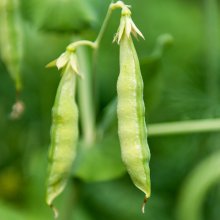Introduction
Yellow peas are one of the oldest-known legumes originated in Southwest Asia. Canada is the worldwide producer of yellow peas while France is the main producer in Europe. It is a sustainable crop that positively impacts the environment by lowering the carbon dioxide consumption and release of greenhouse gases (Tidåker et al., 2021). It has the potential to fix nitrogen during cultivation and hence contributes to the soil fertility with increased crop yields. Global production of yellow peas is higher than that of green peas with six countries as the major producers, including Canada, Russia, India, France, USA, and Ukraine. The ancient Greeks, Romans, and Egyptians all cultivated and consumed peas. They are commonly used in varying sweet and salty preparations, such as American split pea with ham soup, khoresht gheimeh (a Persian stew made with yellow split peas and lamb), a vegetarian Indian staple called dhal, and a sweet snack in China.
Key facts about the crop
Yellow pea is a nutritious crop rich in carbohydrates, dietary fibers, potassium, proteins, and vitamins (A, B, and C). Its high amylose content makes it a perfect ingredient of choice for extruded applications. The use of yellow pea is being promoted in the formulation of fermented foods, such as bakery and vegan (as meat alternatives) products. Fermentation of yellow pea flour can reduce the antinutritional factors (e.g., raffinose, phytic acid, tannins, etc.), that are usually associated with this crop, increasing the bioavailability of nutrients and improved digestibility. The use of fermented yellow pea flour as a replacement of wheat flour in breadmaking has been shown to impact the bread quality and flavour characteristics (Bourré et al., 2019). Consumer preferences are being continuously examined for replacing animal protein with plant-based proteins, where yellow pea plays an important role as an alternative protein-rich ingredient.
Why we are working on this crop in HealthFerm
Yellow pea is well-known for its high nutritional value (high protein and soluble fibers and low-fat content) and sustainability that aligns with the aims and scope of Healthferm to shift the diets from animal-based products to plant-based alternatives. Through this project, we aim to exploit the potential of yellow pea to develop prototypes with enhanced nutritional, texture, and sensory attributes. Ultimately, these prototypes can be introduced in the market after a successful consumer validation by trained panelists.
Curiosity about the crop
- Gregor Mendel used peas for his genetic experiments because of their distinguishable characteristics and short life span. He demonstrated that a cross between green peas and yellow peas always indicated the dominance of yellow peas in the next generation.
- The ripe seeds of yellow peas have antibacterial and narcotic properties.
- In some areas, this crop is considered as a weed as it can infest during the agriculture of other crops, e.g., wheat and rice.
- The seeds of yellow pea contain oxalyl amino acids that can be toxic when consumed in large quantities.





